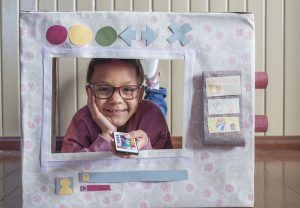
I fell in love the moment my dad brought our first clunky computer home.
Like many other children who grew up in the 1990s, I grew up using computers to write stories and explore the Internet. The term “computer science” conjured a dark cloak of mystery, with a hoodie, or a pair of dungarees. Yet I fell in love with computers and the possibilities that I began to see.
Today, I write picture books about technology to make the world of computers more understandable, inviting, and whimsical for children. The Hello Ruby series has been translated into 28 languages, and some of most enthusiastic readers are primary school teachers. For the past five years, I’ve been traveling around the world and working with teachers from Melbourne to Tokyo, from New York to Tbilisi, helping them see the world of computer science the way I see it: as something beautiful, lovable, and playful.
My most recent project is called Love Letters for Computers, funded by a grant from Dubai World Expo Live. It is a free, 10-part YouTube series intended for primary school educators, covering the basics of computer science with accompanying classroom materials. I wanted to remind teachers how much technology can be about passion, people, and their big ideas. And I wanted everything to look and feel like you‘ve just fallen into a Wes Anderson or Sophia Coppola film.
The videos cover things like hardware, I/O systems, networks, machine learning, as well as diversity & equity. The website includes 28 classroom worksheets, a teacher journal with prompts to reflect upon learning, and other resources to support professional development.
So what did I learn while making this series?
Here are three key takeaways from the Love Letters series:
1. Computer science goes beyond coding.
Teaching computer science in primary school is not just about coding. It’s about helping children develop a love of learning and sharing widely-applicable, long-term ideas. A way of thinking that provides a new perspective to the world. And that’s what computer science does.
We shouldn’t teach computer science just because it’s useful, but because it’s interesting and intensely creative. Computer science blends the intellectual pleasure of reason and logic with the practicality of engineering. It blends the beauty of arts with the change-the-world ethos of social sciences.
The big luminaries of computing like Claude Shannon and Ada Lovelace blended together philosophy, math, and crafts to create modern computers. For the future of computing, we need students to combine their interest in human brains, oboe playing, or nature with computer science to take the field, as well as the world, forward.
And teachers play a huge role in shaping children’s ideas about computer science.
With this series, I hope more teachers start to think about computer science as another tool they can use to express their ideas, just like crayons, posters, or play-doh.
2. Imagination does not oppose science.
I wonder, I wonder, I wonder – what would it feel like to fall inside a computer? What does the Internet look like? Could you teach binary systems with candies?
A lot of the time computer science content is very dull and abstract, especially for young children. Sometimes it can seem as though a teacher’s job is to give out information and then have students repeat it through tests and written text.
How can we better help children find meaning in what they learn and understand the technology they encounter and experience?
With the activities designed for Love Letters, I wanted to create a curiosity cabinet that children could use as points of reference, not as rote techniques.
In early childhood, we use real materials to make connections and build bridges; we create our own renderings and responses to what we experience in the world. That’s why many of the activities invite young students to draw, build, imagine, and interview—mostly without screens. A child’s capacity to construct theories, create meaningful projects, and explore open-ended questions rarely gets used in computer science. Love Letters is more about making memories than transferring knowledge.
3. Teachers deserve hands-on, beautiful, well-thought materials and time for reflection.
Along with the videos and classroom materials, I also designed a reflection journal for teachers. The idea was to help support teachers as learners and as active shapers of the material.
One of the things I’m most excited about right now is starting to see glimpses of love letters in the real world, like these “I wonder” statements from a Dutch teacher, this Norwegian teacher who created an interactive version of one the, and these Singaporean girls imagining what computer scientists look like.
I hope teachers will work as researchers, engage in discussions and interpretation of their own work and the work of their students, documenting the children’s learning process and representations of their thinking around computer science in many media—and sharing them with the world.
So that we can all recognize that it’s not just a computer.
It’s a magic wand.
It’s a guitar.
It’s a telescope.
It’s a treasure finder.
And anything else a child can imagine. ?
- Check out the classroom materials and journal
- Subscribe to the YouTube channel
Linda Liukas is an author, illustrator, mediocre programmer and show runner who is equally inspired by Joan Ganz Cooney, Björk and Seymour Papert.

